
PREV ARTICLE
NEXT ARTICLE
FULL ISSUE
PREV FULL ISSUE
V11 2008 INDEX
E-SYLUM ARCHIVE
WAYNE'S NUMISMATIC DIARY: AUGUST 12, 2008
Tuesday evening was the night of the monthly meeting of my local numismatic social group, Nummis Nova. I left my office about 5:30 and got on the toll road to Tyson's Corner. I pulled into the parking lot of this month's restaurant, Da Dominico.I was early, so I made a quick call on my cell phone to E. Tomlinson Fort in Pittsburgh. Tom is the former editor of our print journal, The Asylum and an old neighbor and fellow member of the Western Pennsylvania Numismatic Society. Tom's planning to host an upcoming meeting of WPNS at his home for a talk on building a numismatic library. Numismatic bibliophiles are welcome as guests, so stay tuned for more information (or contact me and I'll put you in touch with Tom).
I was about to make another call when I noticed a familiar figure milling about the parking lot - it was Howard A. Daniel III, E-Sylum contributor, longtime supporter of NBS, Southeast Asian numismatic expert and all-around good guy. Howard showed me one of his latest acquisitions - an 1866 Burmese gold coin he found on eBay.
As we spoke Julian Leidman arrived. We went inside and found Wayne Herndon sitting all alone at our table. He'd had a long delay with traffic the last time we met in this area, so he'd left his office extra early. No traffic today, so he'd been the first to arrive. Other attendees this night were Tom Kays, Roger Burdette, Traci Poole, Joe Levine and Dave Schenkman.
Roger got a lot of congratulations on his appointment to the Citizen's Coinage Advisory Committee. He told the story of his interview meeting with John Mercanti at the U.S. Mint. A coworker of John's came into the room to tell him she'd finally discovered what had happened to the Lincoln Cent dies and hubs they'd been looking for in connection with new cent designs for 2009 - they'd been destroyed. She learned this from reading one of Roger's Renaissance of American Coinage books, which she carried with her. John introduced her to Roger.
I got several congratulations as well for winning the Burnett Anderson Award for Numismatic Writing. The night before I'd prepared a binder of ephemera related to the award and the ANA banquet and convention. Included were the announcement letter from the ANA, our banquet ticket stubs and menus, and ANA programs (the show program, Numismatic Theatre program, Exhibit program). I passed the binder around along with my medal and award plaque.
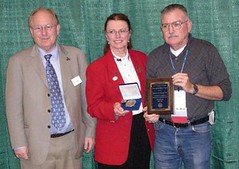 Howard was also congratulated for his winning
of the ANA's Glenn Smwedley Award for his volunteer work at the ANAs and
for other organizations, and manning a club table for NBS, NI, IBNS and
the PCF. In a photo provided by John Wilson, here's Howard receiving his
award with ANA President Barry Stuppler and VP Patricia Finner.
Howard was also congratulated for his winning
of the ANA's Glenn Smwedley Award for his volunteer work at the ANAs and
for other organizations, and manning a club table for NBS, NI, IBNS and
the PCF. In a photo provided by John Wilson, here's Howard receiving his
award with ANA President Barry Stuppler and VP Patricia Finner.The theme for our meeting was the recent ANA show. All in all it was successful for everyone. Tom Kays polled several dealers and all were quite happy. Joe said that one dealer he spoke to had his best show ever. Wayne was very pleased with the response at his coin tables and Wizard Coin Supply section. By the end of the show there was a lot of white space showing where numismatic books were stacked at the beginning.
Speaking of numismatic books, I passed around a copy of the new 100 Greatest Ancient Coins by Harlan Berk. Other books discussed included Katie Jaeger's Guide Book of U.S. Tokens and Medals, Rita Laws' book on Indian Peace Medals, and a new book by Ira Reed on The Jamestown Exposition of 1907. The book discusses the medals issued for the exposition.
A mention of John Ford prompted Joe Levine to recall running into Ford, in of all times and places, in Paris while on his honeymoon. Ford was there visiting old haunts from his service in WWII with his son in law's father. They were staying in the same hotel. Ford escorted Joe and his new bride around Paris, recounting stories of the war, his encounters with Nazis, and the black market in cigarettes. While on that same trip, the Levines ran into Paul Bosco at a coin convention in the Paris suburbs where he had a bourse table. Also, by prior arrangement, they were treated to dinner at a fine Paris restaurant by Richard Margolis and his wife.
My only book purchase was a copy of Good Money by George Selgin. Roger purchased the special leatherbound version of Len Augsburger's new book Treasure in the Cellar. Tom passed around a book he purchased at the show, the American Numismatic Manual by Montroville Dickeson.
Dave Schenkman passed around his purchase from the recent Stack's Dice-Hicks collection auction - lot 3435. It's a token of S.T. Suit of Jefferson County, Kentucky. Very rare in white metal, the 1850-dated token is Miller Ky 39. He told an interesting story about the issuer, a whiskey distiller. He fell in love with a much younger woman who refused to marry him. She relented when he promised to build her a castle - a real castle. He died before the massive home was completed.

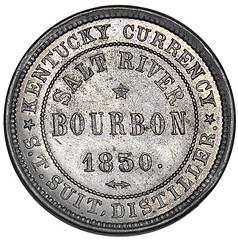
To view the complete auction description, see: Lot 3435: Kentucky. Jefferson County. S.T. Suit. 1850. Miller Ky 39. (http://www.stacks.com/lotdetail.aspx?lrid=AN00098078)
Tom Kays passed around a nice group of Spanish silver, including a cool countermarked 1773-dated quarter dollar piece. Tom writes:
Regarding the Bank of England and the coin shortage of
1797, one wag wrote: The bank to make their dollars pass stamped the head
of a fool on the neck of an ass. Others remarked: Here are two kings
together not worth a crown. Spanish milled dollars of Charles III and
Charles IV with the diminutive George III oval punch were to pass for 4
shillings, 9 pence, or three pence short of an English Crown.

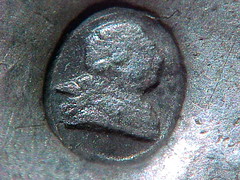
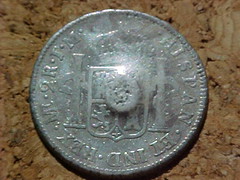
The George III punch, in use since 1784, is reminiscent of the London Goldsmiths duty mark used on jewelry and plate to denote a fee per ounce of precious metal had been paid the Inland Revenue. Goldsmiths presides over the elaborate Trial of the Pyx to certify to a jury coinage of the realm has proper gold and silver content. It makes sense that they would apply the mark. Besides dollars, this mark is scarce on Spanish half dollars and rare on smaller denominations.
By 1804 the countermarked dollars were being counterfeited, and the George III punch is said to have been used in more modern times to make fantasy pieces for collectors. Regarding this one shilling, two pence, farthing piece do any readers know how to tell the genuine from the fantasy?



The George III punch, in use since 1784, is reminiscent of the London Goldsmiths duty mark used on jewelry and plate to denote a fee per ounce of precious metal had been paid the Inland Revenue. Goldsmiths presides over the elaborate Trial of the Pyx to certify to a jury coinage of the realm has proper gold and silver content. It makes sense that they would apply the mark. Besides dollars, this mark is scarce on Spanish half dollars and rare on smaller denominations.
By 1804 the countermarked dollars were being counterfeited, and the George III punch is said to have been used in more modern times to make fantasy pieces for collectors. Regarding this one shilling, two pence, farthing piece do any readers know how to tell the genuine from the fantasy?
Tom also notes that a number of chop marked Spanish dollars were uncovered during dredging on the Maryland side of the Potomac during the recent construction of the Wilson Bridge which carries Capitol Beltway traffic across the river. Hundreds of coins from colonial to modern date and other artifacts such as Civil War era belt buckles surfaced as the initial dredge material was dumped in Virginia and slumped or subsided after hurricane rains revealed a glittering field of glass and metal artifacts on top for one rainy day, before many more dump truck loads buried it all again quite deep. Tom had written about the hoard in the Virginia Numismatic Association Journal a couple years ago. Many thanks to Tom for providing these images of his coins.
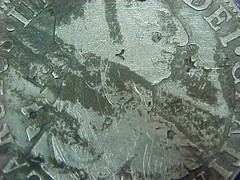
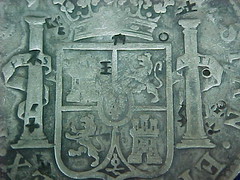
The Civil War mention reminded me of an article I'd read the other morning in The Washington Post. It seems the Civil War claimed its newest casualty just a few months ago.
A Civil War relic hunter who was killed in an explosion
in February had been cleaning a cannonball when a spark ignited black
powder, a federal investigation concluded yesterday.
Sam White, 53, was working on the nine-inch naval cannonball in the driveway of his home with a wire-brush grinder, which ignited the internal powder, exploding the shell, the Bureau of Alcohol, Tobacco, Firearms and Explosives said. No other injuries were reported in the Feb. 18 explosion.
The explosion sent a one- to two-pound section of the shell hurtling from the Chester subdivision where White lived and through the roof of a house a quarter-mile away.
White, a respected, widely known member of the Civil War relic hunting community, was using the grinder to clean residue from the shell, which dated to the 1850s or 1860s.
Sam White, 53, was working on the nine-inch naval cannonball in the driveway of his home with a wire-brush grinder, which ignited the internal powder, exploding the shell, the Bureau of Alcohol, Tobacco, Firearms and Explosives said. No other injuries were reported in the Feb. 18 explosion.
The explosion sent a one- to two-pound section of the shell hurtling from the Chester subdivision where White lived and through the roof of a house a quarter-mile away.
White, a respected, widely known member of the Civil War relic hunting community, was using the grinder to clean residue from the shell, which dated to the 1850s or 1860s.
To read the complete article, see: Spark Ignited Powder in Civil War-Era Shell (http://www.washingtonpost.com/
wp-dyn/content/article/2008/08/11/AR2008081102365_3.html)
J. Sanford Saltus aside, at least collecting coins won't kill you. Midway through our dinner we were treated to (some might say subjected to) a rendition of "O Sole Mio" in the booming operatic voice of one of the staff. All in all, it was another memorable evening of numismatic fellowship. If any readers in the greater Washington D.C. area would like to join us sometime, let me know.
Wayne Homren, Editor
The Numismatic Bibliomania Society is a non-profit organization promoting numismatic literature. See our web site at coinbooks.org.
To submit items for publication in The E-Sylum, write to the Editor at this address: whomren@gmail.com
To subscribe go to: https://my.binhost.com/lists/listinfo/esylum
All Rights Reserved.
NBS Home Page
Contact the NBS webmaster
